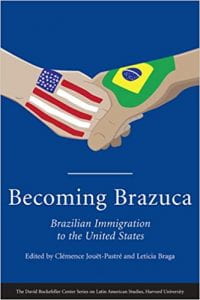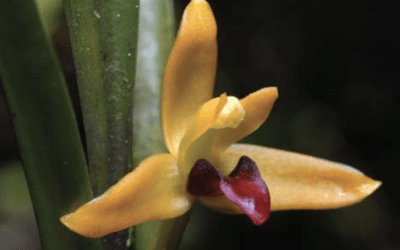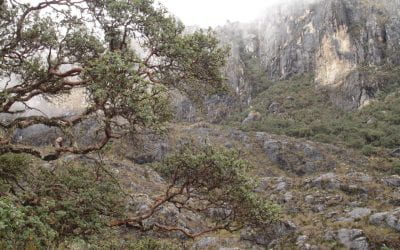A Review of Becoming Brazuca: Brazilian Immigration to the United States

Becoming Brazuca: Brazilian Immigration to the United States Edited by Clémence Jouët-Pastré and Leticia J. Braga (David Rockefeller Center Series on Latin American Studies, Harvard University Press, 2008)
Trying to define the community of Brazilian descendants who studied at Harvard University between 2001 and 2005, when I attended the college, was a maddening exercise. Some Crimson Brazucas—or Brazilian immigrants in the United States—affiliated with the broader community of Latino immigrants and participated in Concílio Latino or the annual pan-Latin cultural show, Presencia Latina (which I co-founded in 2002); some linked into the community of foreign students (often from upper classes) and hung out with the “debonair” European crowd or the cosmopolitan Middle Easterners. Afro-Brazilians were drawn to one of the African-American communities; others simply ignored their South American roots. The Unofficial Guide to Life at Harvard listed ten groups that directly addressed Latino concerns. If there is one thing to be said with certainty, it is that the Brazilian students floated unidentifiably in the periphery of those options.
Only upon reading Becoming Brazuca did I learn that this issue—“of community among Brazilian immigrants and community-based institutions or rather the lack thereof” [my stress]—now has an academic label: “Brasphobia,” as identified in 2003 and subsequently described by Maxine Margolis in the book’s final chapter. Not surprisingly, many Brazilians living in the United States deny their South American identity. Margolis tells one story, of an immigrant living in South Florida, who told an interviewing anthropologist, “I was Brazilian.”
Had Becoming Brazuca existed when I first conducted ethnographic fieldwork among the community of Brazilian immigrants—often undocumented—in nearby East Cambridge, and then for my Social Studies thesis focusing on the performance of national identity during Carnaval, I would not have felt so alone in my research and so lost in my methodology. For Brazilianists, this collection of essays illuminates the myriad methodological issues involved with studying Brazilians, drawing across a range of subject matters. The book examines its respondents from their roots—going back to Brazil, where a sending community, Governador Valdares, is explored—and continues through to second-generation immigrants in the United States, with stops along the path of migration and acculturation.
As the series of essays rightly points out, the question of U.S.-based Brazilians is given short shrift in immigration studies: it is seen as a small and unique group, especially since large-scale migration from Brazil to the United States is a fairly recent phenomenon. Some might believe that research on this topic does not advance broader questions regarding more populous cultural groups. However, this edited volume convincingly argues the contrary. For one, Brazilian immigration has been on the rise: in the past five years, Brazil has joined the top ten source countries for unauthorized immigration. Figures for this population have long been inaccurate and, many believe, short of the reality. Though the 2000 U.S. census counted only 212,000 Brazilian-born or Brazilian-descendant immigrants living in the States, and the 2004 American Community Survey identified about 282,000, it has been estimated that in 2001, 800,000 to 1.1 million resided here, according to Eduardo Salgado as cited by Margolis.
More than just the fact that Brazilians are a booming minority group, the other important argument for studying theBrazuca experience is that anyone focusing on immigration can learn broadly from the particular quality which makes researching Brazilian immigration so challenging: since they can be identified according to so many categories, their experiences extend to other groups of immigrants to the United States. The interdisciplinary approach presented in this series of essays is one that applies beyond one sub-culture. Becoming Brazuca offers methodologies and theories that illuminate immigration on a global scale, where single identifiers are inadequate for the real-world complexities we face.
It is in its ability to incorporate an interdisciplinary approach, and then to make those strategies accessible to readers, that the book most excels. Becoming Brazuca is approachable from the first page: it goes so far as to define important identifiers that might leave newcomers or outsiders to the field in confusion (it even defines “Latino”).
Readers learn about the contemporary academic concerns regarding Brazucas, offering perspectives on the past, present, and future of Brazilian immigration to the United States. Clearly, editors Leticia J. Braga and Clémence Jouët-Pastré are not only pushing the dialogue further—they are also fomenting a retrospective concern with which to contextualize the work of the 24 contributors. As Carola Suárez-Orozco wrote in the prologue, “These chapters represent emerging scholarship of the most eminent Brazilian and American researchers of the Brazilian diasporic experience. The book provides a much needed view into the richness and complexity of the Brazilian-North American community.”
Many of the chapters address methodological and theoretical gaps in research on Brazilian immigration as well as the broader questions of immigration research that Suárez-Orozco asserts:
The variety of issues affecting Brazilian immigrants suggests that there are different perspectives to be considered and, therefore, there is a need for a national view of Brazilian immigration that encompasses interdisciplinary research.
For a taste of the interdisciplinary nature of the compendium, consider the work of Else R. P. Vieira, of Ana Cristina Braga Martes, and of Kátia Maria Santos Mota. The former focuses on Brazilian media, first as television imported from abroad and then in print publications, and how these are utilized as a means by which identity and community are formed and negotiated. The second uses a “microeconomic issues development approach based on a non-representative but in-depth sample from Boston and from Governador Valadares,” the Brazilian city with the largest number of émigrés to the United States. The third is a linguistic approach and traces aspects of language behavior in a bilingual situation, where the immigrant must navigate between their Portuguese-speaking families and the larger, English-speaking world.
Becoming Brazuca succeeds, moreover, in its detailing of the distinctive challenges which face anyone undertaking research on Brazilians U.S. residents. Many of the authors agree that “to date, far too little systematic work has been done on the Brazilian immigrant experience.” One important reason for this neglect is detailed in the prologue:
Research on immigrant origin groups tend to be focused on so called ‘problem populations’ or on ‘model minorities’ (Lee, 1996). Yet groups that tend neither to overachieve nor to dramatically underachieve are often under-researched—no doubt contributing to the woeful understudy of Brazilians.
The dearth of reliable data was referenced on numerous occasions. Estimates for numbers of Brazilian immigrants residing in the United States today vary widely, in part because many undocumented Brazucas are not counted, but also due to an evolution of categorization systems over the course of more than twenty years since Brazilians began immigrating in mass numbers to the United States. Other changes that the census must consider include “changes in immigrants’ demographic profile, projects of return, and methods of entry.” To understand how much the immigrant identity has changed, consider that “in the 1980s, the majority of Brazilians tended to be young, male, middle or lower-middle class, more light-skinned, and more educated than the average population in Brazil…This depiction of Brazilian immigrants, for the most part, does not hold true anymore” we learn in the Introduction.
As C. Eduardo Siqueira and Tiago Jansen detail in their chapter, census data collection and analysis have done little to describe this new and under-represented group, as the census lacks an appreciation of distinctive socio-cultural and economic categories. For example, Brazilians consider race and nationality differently from most Latinos. “Unlike most immigrant groups from Latin America, Brazilians…come from higher socioeconomic classes, and have an ethnic and racial self-identification that does not easily fall into the American “Hispanic” or “Black” categories in which they are often placed.” As a result, many reject this designation. Any system for recording immigrants must adapt to appreciate foreign identity distinguishers.
Of course, one crucial element of studying the Brazilian immigrant population is having Portuguese-language abilities; perhaps even more difficult to articulate but no less important is the need for researchers who straddle both a U.S. and Brazilian culture (if not a third culture as well, that of being neither and both Brazilian and American). Writing on health issues, Clémence Jouët-Pastré, Branca Telles Ribeiro, Márcia Guimarães and Solange de Azambuja Lira elucidate their commitment to avoiding any a priori expectations, which demonstrates a clear understanding of the need to let the respondents indicate their most important narratives—rather than enforcing an agenda from either a Brazilian- or U.S.-oriented perspective. Joshua Kirschner spoke about ways Boston-based labor unions are recruiting Brazilian immigrants and describes the efforts, since 2000, of the American Federation of Labor-Congress of Industrial Organizations (AFL-CIO) to reach out to immigrant workers in a changing global economy.
That Becoming Brazuca provides a background on what’s been done, what’s being done, and what has yet to be done in research focusing on the Brazilian immigrant experience indicates that a certain amount has been accomplished already. It is a groundswell allowing a moment to look around from atop the hill just climbed. A thorough, thoughtful compendium whose lessons extend beyond its particular respondent set, and as Braga and Jouët-Pastré assert, one whose “methodological and theoretical perspectives…are applicable to the greater study of immigration as a global phenomenon.”
Related Articles
Making a Difference: Taking on Tropical Diseases
Harvard School of Public Health (HSPH) students, along with their Brazilian counterparts, spent January studying and devising ways to control two tropical diseases endemic in Brazil: visceral leishmaniasis (VL) and schistosomiasis. During two intensive weeks in Brazil, students explored the epidemiological, biological, and clinical characteristics of selected infectious diseases, as well as the social, cultural, economic, and …
Collecting Orchids In the Venezuelan Orinco-Amazon Interfluvium
Orchidaceae are by far the largest family of all flowering plants, with species occurring all over the planet except in its very coldest and driest habitats. However, as is the case with most other living organisms, orchids are not evenly distributed. Most species grow in the tropics; as we approach the poles, their numbers diminish rapidly. The United States and Canada, for example, have approximately 208 species, Mexico, some 1250 species …
Plants Under Stress in the Tropical High Andes: Learning from Venezuela and Beyond
Tropical mountains are privileged places for ecological studies. Going up and down the slopes, like the ones surrounding my home town of Merida, Venezuela, we may simulate changes in temperature. While moving from one slope to the next or moving along seasonal precipitation gradients, we may study plant responses to water availability. These studies have shed light on identifying possible climate change effects on …




